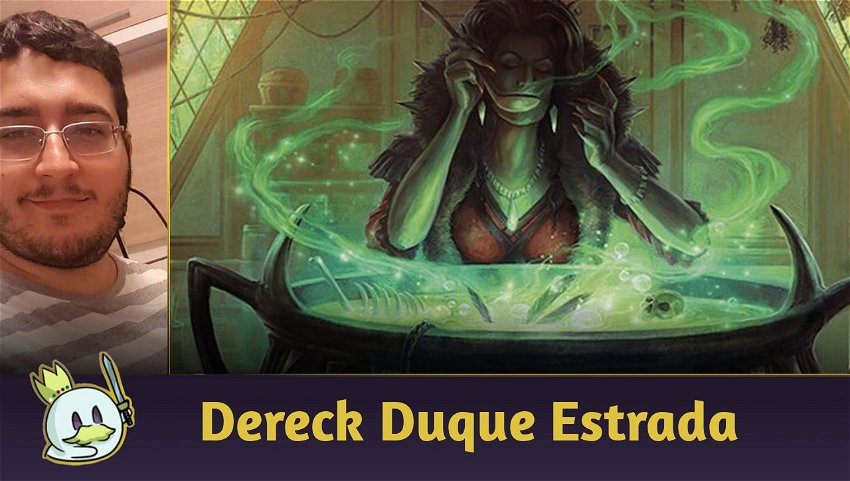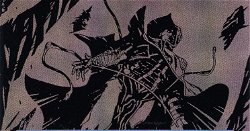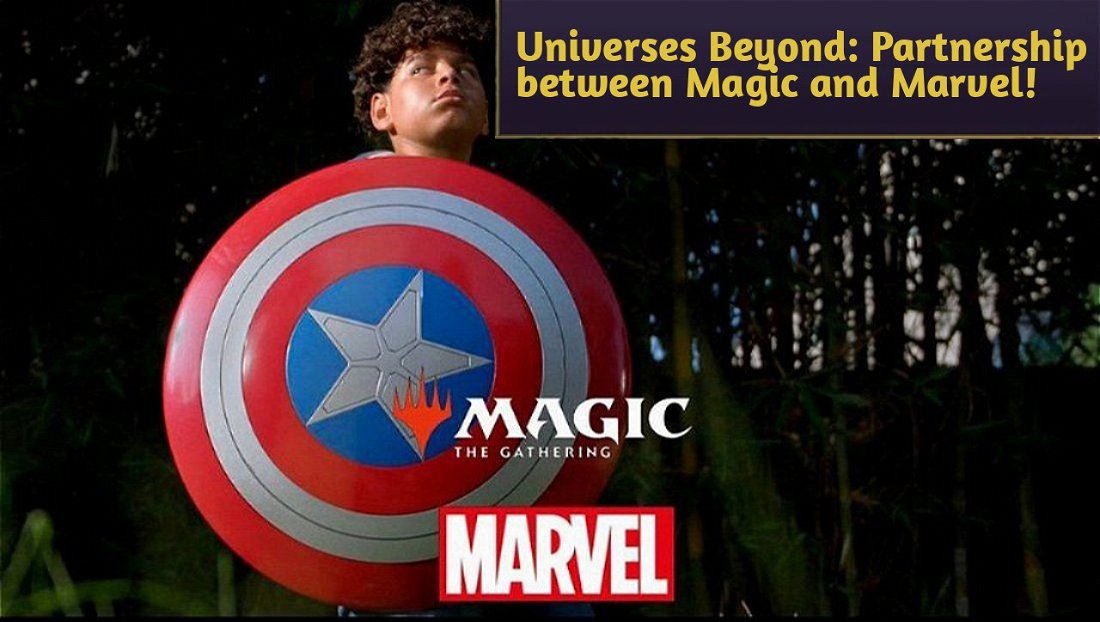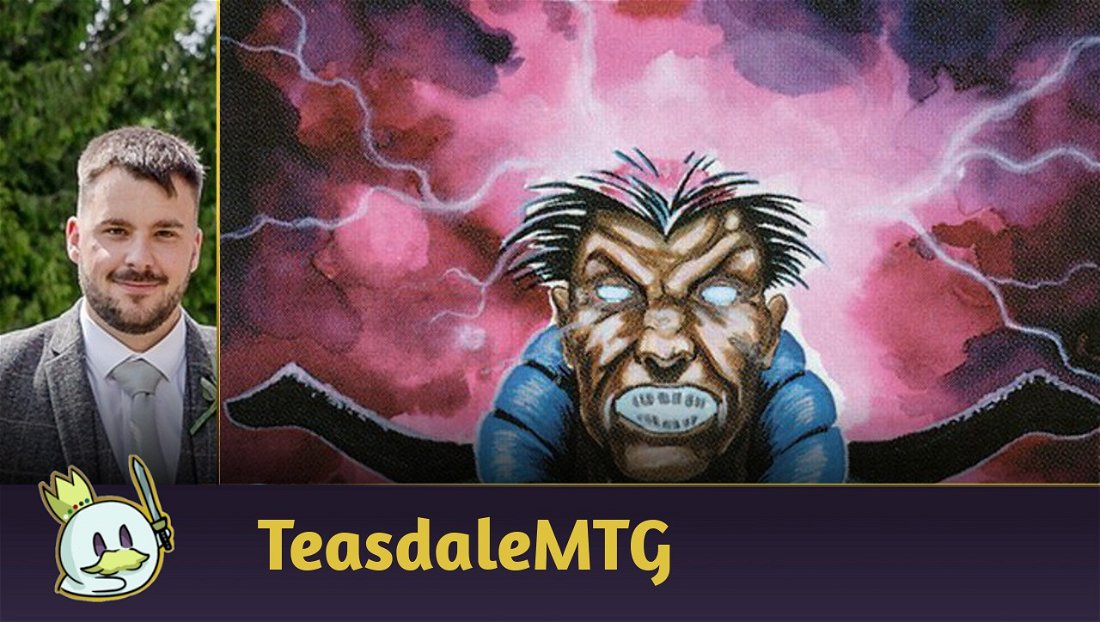Introduction
With the release of Wilds of Eldraine (WOE), we have seen many cards be tested in Standard, some more successful and others less so. Agatha's Soul Cauldron, unfortunately, hadn't found its space in decks present in Standard meta so far.
Like so, Simic Cauldron came to be, a deck built around using some creatures' abilities to close out the game.

Deck Tech
We'll work with two decklists: the first one is based on the deck that got ninth place at Worlds, piloted by Alexey Paulot.
The other decklist was a small variation of the original list to add Mishra's Foundry to the deck, and with that have another win condition.
I'll present both (Alexey's will be placed at the end of the article), but I'll work more on the second list, in which we swapped a Brave the Wilds for Mishra's Foundry.
Decklist with Mishra's Foundry
Strategy
This deck's plan is to place a sequence of pieces in the graveyard, exile them by using Agatha's Soul Cauldron and this way create infinite mana and end the game, or look for the necessary pieces to end the game. Describing it briefly like this makes it seem quite simple, but the process is a bit more complex.
Besides this, the deck has a series of spells and permanents that are intended to feed the graveyard to find the pieces that are missing.

Fallaji Archaeologist, Wrenn and RealmBreaker and Seed of Hope feed the graveyard while they allow you to return Agatha's Soul Cauldron to your hand.
Teachings of the Kirin, Jace, the Perfected Mind and Argoth, Sanctum of Nature are also pieces which will feed your graveyard, even though they won't allow you to reuse whatever they mill. This way, they should be paired with Unnatural Restoration.
This deck has many creatures with abilities to use with the artifact.

This is the base you'll use to create infinite mana with this deck; one of the two creatures on board and the other in the graveyard being exiled by Agatha's Soul Cauldron, or both in the graveyard exiled and another creature with a counter with 3 or more power.
Like so, you'll be able to create three mana of any color and use two to untap. Remember that, if you have Sleep-Cursed Faerie on board, the necessary mana to untap it is blue, and not any color mana, which is what it would need if it was activated by the Cauldron, and this is something very relevant to know when you're piloting the deck.
After creating infinite mana, there are a few ways to close out the game, which depend on a few conditions that must be met:
Finding the Necessary Piece - Rona, Herald of Invasion

After setting up your infinite mana, you need to find the other pieces required. So, the best option is to provide Rona, Herald of Invasion's abilities to feed Agatha's Soul Cauldron and this way draw and discard cards, untap them using Sleep-Cursed Faerie's abilities and repeat the process until you find Realm-Scorcher Hellkite.
Closing Out the Game

To close out the game using Realm-Scorcher Hellkite, we need to create enough red mana to cast this creature and deal lethal damage with its ability.
With the infinite mana setup, that isn't an issue - but, if the creature is countered, you might end up losing your main way of ending games. If the counter in question isn't a Dissipate or Syncopate, which exile the countered spell, it is still possible to cast a new Agatha's Soul Cauldron and exile the Dragon, giving another creature the necessary abilities to end the game.
Another option is accessing Unnatural Restoration to return the Dragon to your hand and this way cast this spell again after it was countered.
Ending the Game with Mishra's Foundry
By using the land Mishra's Foundry, we can share counters with Agatha's Soul Cauldron, this way gaining abilities from creatures exiled through the artifact. With Sleep-Cursed Faerie and Kami of Whispered Hopes, it is possible to create infinite mana during the attack, spending two mana to untap the land.
Like so, activate the land's ability, granting it +2/+2, and next untap the land and reactivate its ability, increasing its power. It is an excellent option to end the game when the opponent thinks they've dealt with all threats on board.
Mulligan Guide
As this is a combo deck, the Mulligan can be a very strong alternative to accelerate the process. Mulliganing for 5 or 4 cards isn't as punitive if we can sequence it with the necessary pieces.

This combination of 5 cards is the base of the combo, and it can offer you 21 cards that might offer you a sequence in the deck and speed up the combo. Rona, Herald of Invasion is one of the best complements possible for this sequence. So, even with a bigger Mulligan, you can still get the full combo in a small amount of time with a good sequence of draws.

This is a combination a bit less aggressive, but it provides you with the possibility to develop your game plan. Seed of Hope can be used to guarantee your land drop, Fallaji Archaeologist and Rona, Herald of Invasion allow you to look for your combo or find more ways to feed your graveyard and prepare the scene for the Cauldron.
It is a grindy option, which forces you to work with your resources thoroughly, and it does end up being a viable hand for a Mulligan for 5 scenario.

This is the best hand your deck can have: we have all the pieces to play the combo in hand, we start with the best creature, which is unlikely to be removed before turn 4, and we can feed the graveyard and start giving abilities to our creatures.

Right above, we have a hand example which obviously requires a Mulligan. Besides not having a progression, we don't have the necessary mana to play Jace, the hand is heavy, and we don't have access to the necessary color to use the only cheap spell we have.
Hands with too many lands are also hands we need to Mulligan, because it is important to develop our setup on the first few turns or at least feed our graveyard. In the case above, we do neither of these two - therefore, it's best to Mulligan.
Seed of Hope is a guarantee to keep if we have just a few lands in hand. It is very hard to not find lands on the first 3 cards to guarantee your second turn and this way develop the board, considering the deck doesn't need much more than 3 lands available to work.
Another precious card is Fallaji Archaeologist, which, besides feeding the graveyard, can many times look for Agatha's Soul Cauldron or a way to sequence cards feeding the graveyard. These are the two cards that allow you to correct your Mulligan if you keep them.
Problematic Opponent Cards
In the current scene, there are a few decks with cards that act as "sideboard" in the main deck and should be played around, so we can win the game. We'll discuss the main ones below.
Dennick, Pious Apprentice

Dennick, Pious Apprentice is by far the most effective card against Simic Cauldron. Its static ability prevents us from exiling cards with Agatha's Soul Cauldron, completely stopping the deck's strategy and making it very hard for you to develop the game.
Otawara, Soaring City and Witness Protection are alternatives to get back in track with the combo.
Sheoldred, The Apocalypse

One of the main ways you'll complete your combo is through Rona, Herald of Invasion bringing draws - and with Sheoldred, The Apocalypse on board, draws become risky, which will stop us from searching for our pieces.
The way you'll deal with Sheoldred is the same way you'll deal with Dennick, but, it is still possible to draw the entire deck, even though the combo alternative becomes entirely dependent on Agatha's Soul Cauldron. You must activate Rona's ability, keep Sheoldred's trigger on the stack and go through the steps to draw your entire deck after creating infinite mana, leaving all Sheoldred triggers on the stack without resolving.
If we can play Realm-Scorcher Hellkite into the graveyard, we can exile it with the cauldron and this way finish the game before Sheoldred's triggers resolve.
Farewell e Sunfall

These two are the most popular global removals currently. Farewell, besides exiling creatures, artifacts and enchantments, also exiles the graveyard, undoing all the work we've done to setup our deck's strategy.
A more aggressive strategy is the best answer against decks that use these pieces, focusing less on the combo and worrying about punishing Life points more.
Wrenn and Realmbreaker is a viable option to go around this spell and carry on pressuring the opponent.
Sunfall, even though it doesn't entirely ruin your board setup, prevents you from getting recursion out of the pieces which have already been cast, as these creatures will be exiled.
Even though they tend to play together, Farewell has been losing space to Sunfall because of their mana cost, so using just a few pieces to look for your combo and stacking abilities might be beneficial. Using Planeswalkers and enchantments is also useful.
Sideboard Guide
The sideboard is quite linear. As this combo depends on the main pieces being on the board, it is usual for opponents to try and remove these pieces. So, our sideguide will be focused on protecting our pieces in these cases.
Against Aggro decks, our sideboard will be focused on preserving our Life points and removing enemy threats.
Esper Midrange
Side In

Side Out

Another option is keeping the combo:

With Dennick, Pious Apprentice on the other side, it is quite complicated to fit your combos, so we decided to take it out of the deck and go for a Argoth, Sanctum of Nature line alongside Titania, Voice of Gaea, keeping a more aggressive strategy on our side.
Other cards are focused on guaranteeing the deck's board progression and protecting it from removals and counters.
Domain Ramp
Side In

Side Out

Against Domain Ramp, the key is avoiding getting hit with a Leyline Binding removing Agatha's Soul Cauldron's entire progress - and it is essential to have an Outland Liberator on board to remove the enchantment before exiling the artifact, or even have a Tamiyo's Safekeeping to protect it.
Remember Outland Liberator's ability can be transferred through the cauldron's ability, and like so it is possible that any creature with a counter is capable of protecting the combo.
Azorius Aggro
Side In

Side Out

In this match, Wrenn and Realmbreaker is a very slow card, and this delay period can be what the opponent needs to finish setting up and fit in a lethal attack.
Titania, Voice of Gaea, besides being able to block the opponent's Flying creatures, can gain life when lands go to the graveyard, and might provide more time for us to finish setting up.
Outland Liberator, besides offering us a 3/3 when it is Nightbound, can deal with the opponent's Wedding Announcement, allowing other creatures to do the same later on.
Golgari Midrange
Side In

Side Out

This strategy tries to minimize the opponent's Cut Down effects, building a stronger board with Titania, Voice of Gaea and Slogurk, the Overslime and creating more relevant threats as we look for our combo.
Some points to keep an eye on are Outland Liberator and Nissa, Ascended Animist, which can remove artifacts and disrupt the combo. Glissa Sunslayer can also remove counters from creatures and prevent us from using the cauldron's abilities.
Mono Red Aggro
Side in

Side Out

Against Aggro decks, in general, we always add Titania, Voice of Gaea for its life gain.
We need protection to preserve our creatures, as they are resilient enough to hold off the opponent's might.
Ideally, you'll stabilize with a big board and grow bit by bit with Agatha's Soul Cauldron, going out of the range of possible removals, besides using Witness Protection and Animist's Might against more problematic creatures.
Decklist - Alexey Paulot
Final Words
Simic Cauldron is a somewhat fun to pilot deck, capable of bringing versatile plays and carrying the potential to be developed as sets are released.
The experience of using and facing this deck in Magic Arena is frustrating, and it is necessary to go through each of the steps to create mana, which takes too much time, and creates mistakes because of the repeated actions - not to mention the mana loss because you changed steps accidentally or because the time turner's time has run out.
In the current metagame, this deck struggles to fit somewhere, and the many Midrange decks make it a challenge to bring this strategy structure, which stumbles on its own dependency on creatures.
Another difficulty factor is the almost constant presence of cards such as Dennick, Pious Apprentice and Sheoldred, The Apocalypse, which practically disrupt our entire game structure. I believe there is a lot of potential in this deck as we acquire the new sets that are to come, and I also believe there might be a way to solve the current game issues.
If you have any questions, comments or compliments, share them with us in the comment section.
See you in the next article! Cheers and see you then.















— 评论 0
, 反应 1
成为第一个发表评论的人